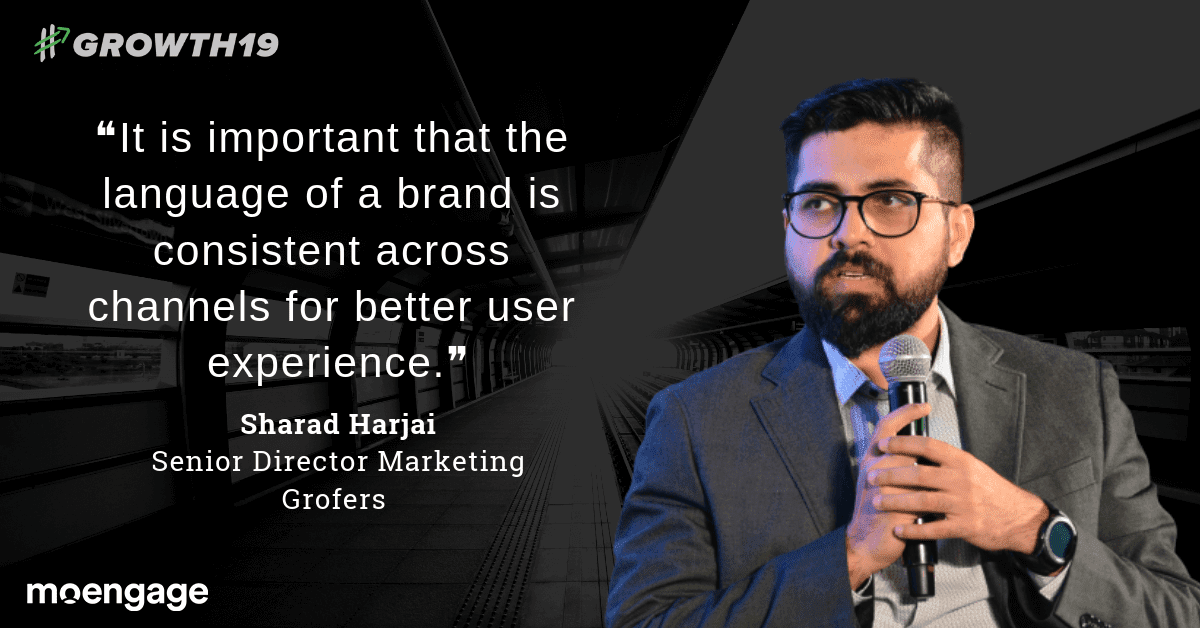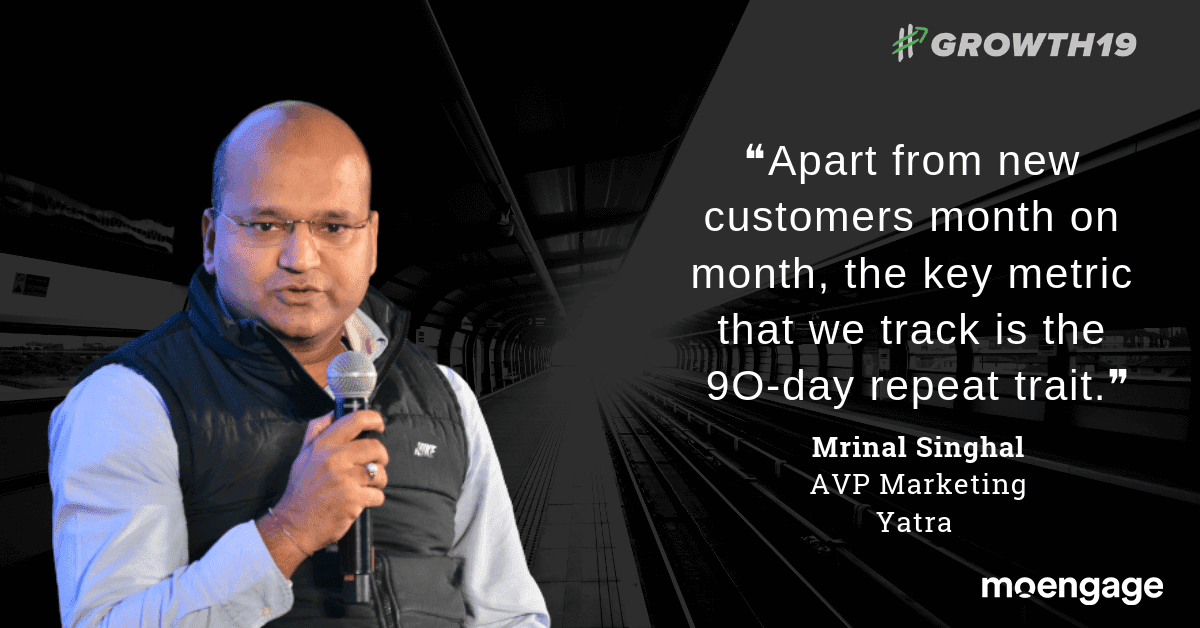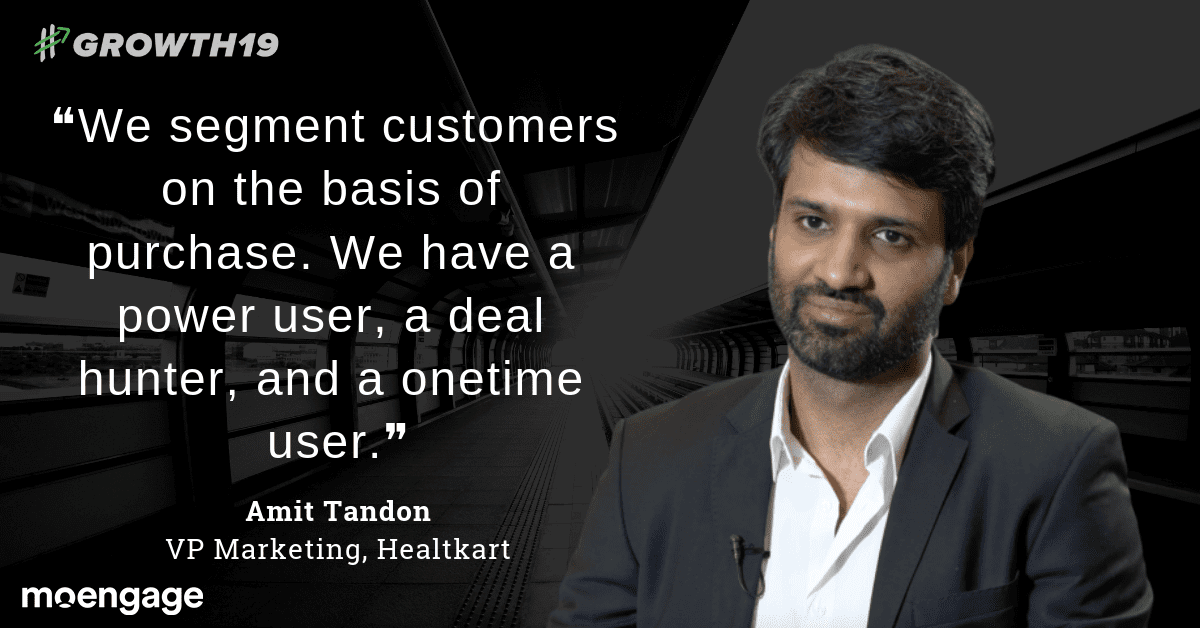How to Build a Brand and Customer Loyalty [#GROWTH19 Wrap-up]
![How to Build a Brand and Customer Loyalty [#GROWTH19 Wrap-up]](https://www.moengage.com/wp-content/uploads/2020/07/How-to-build-a-brand-and-customer-loyalty.png)
Reading Time: 8 minutes
In today’s hyper-connected age, there is no single way to connect with your customer. Customer journeys have become more complicated than before, and marketers have to constantly find ways to break the clutter and engage with customers through multiple channels such as e-mails, SMSes, apps, websites, offline, etc in order to boost customer loyalty.
How to Build a Brand and Customer Loyalty
We invited Mrinal Singhal, AVP Marketing, Yatra, Sharad Harjai, Sr. Director Marketing, Grofers, and Amit Tandon VP Marketing, HealthKart to learn how they have succeeded in building their brand and a robust customer loyalty program across the digital and offline platforms. The panel discussion was moderated by Yashwant Reddy, VP at MoEngage.
We bring you the excerpts from the discussion.
How do you engage customers across different channels such as paid media and social media? How do you decide what kind of message should be used?
Sharad: With so many channels at our disposal, maintaining consistency in the brand’s language is important. It is important how you position each product. It’s not just the text; even the design should be taken care of. It should give the buyer the confidence to buy from the portal. To maintain consistency, we have built a team architecture that’s less focused on calling people channel owners such as social media heads, or digital marketing heads. Instead, we have divided the entire team into two areas based on metrics – acquisition and retention. So, if a person is driving a campaign based on one metric, then the focus is not on which channel to use to communicate with the customer. The focus is on the larger metric, and that brings consistency to the campaign. If the campaign is to improve downloads and conversions, everyone involved in the campaign has to be a part of the entire process. Everyone works cohesively for the larger benefit of the metrics.

Mrinal: We have multiple touchpoints to explore, so the challenge is to get the consumer’s attention. At Yatra, we follow two metrics to engage with the customers. One, to keep the messaging very simple. We must understand that we are sending a message to the consumers and not marketers. The second thing we stress upon is the user’s journey. We ensure that the consumer’s journey from communication to the point where they make a booking is seamless and does not have any broken/slow links. So, irrespective of whether the campaign is large or small or covering different touchpoints, we ensure the basic principles of simple messaging and a simple customer journey is followed. In terms of team structure, we do not function in silos. Whenever there is a business challenge to be solved, all the channel experts sit together to decide on the best channel to work upon.
Amit: Engagement is less of a challenge for us as customer loves to engage in health and wellness especially when they want to know more about particular products. In fact, we get a lot of inbound queries. For us, the challenge is maintaining a consistent omnichannel experience, which we are trying to build now. We are trying to integrate our physical footprint with the digital footprint to provide a superlative experience to our customers. For example, if the customer buys a product online, they should be able to return it at the nearest store, or they can buy a product online if it is not available at a store. In terms of how our team is structured, we have a common centralized marketing team to provide a consistent experience in both digital and offline stores. We also have a centralized training team that trains every storefront executive about the domain and store ethics to ensure that the messaging on digital medium and in-store remains consistent. The consistent experience has increased the Customer Lifetime Value (LTV). The customers engage more with the portal because of the relationship they have developed with the store.
What metrics do you measure to track the health of growth besides vanity metrics such as installations, downloads, and the number of new users?
Sharad: For us, the Northstar of our metrics is the monthly wallet share the consumer gives to Grofers. A typical family of 2-3 people spends around 7,000 to 8,000 Rs each month on grocery. Global survey says that the maximum share any offline or online platform can have for the minimum amount spent on grocery by a family is around seventy percent. Achieving this kind of share is a challenging task as you cannot lose track of a customer at any moment. You have to be at the top of things. Your engagement channel should be in tune with how your customer buys. Customer engagement must revolve around how the customer buys every month. For example, customers do monthly top-ups on the day the salary is credited. By the end of every month, we analyze the wallet share we could get from a customer. We also monitor the replenishment cycle when it comes to eatables. One of our best resulting engagement campaigns is where we understand when a customer is going to buy what. It is easy to find out how does the household look like, how big is it, and depending upon when a customer is going to buy a product, we work on the re-engagement campaigns. It is one category that has given us great results.
Mrinal: Unlike groceries, travel is not a very frequent use case. An average customer makes two to four bookings in a year and they look for the best deals in the market. Apart from acquiring new customers month on month, the key metric that we track is the 9O-day repeat trait. We monitor how the lifetime value looks like – is it moving up or down or is it flat? These are the two metrics we measure to determine if we are moving in the right direction.

Amit: We look at two metrics – repeat and new. In our category, we always have new customers. However, the repeat metric is equally important for us. Within repeat, we see if we can upgrade the customer’s experience and move them to a more core product. We track repeat records regularly to check out the health of our business and to figure out if there was an event that led to the exit of our loyal customers. Given that the target group is quite finite, Net Promoter Score (NPS) becomes our core metric. We do weekly NPS checks and keep on changing our benchmarks to track the NPS.
Do you want to discuss a specific use case on how loyalty programs can drive repeat business?
Sharad: In 2O17, Grofers moved from a marketplace model which served multiple categories to an inventory-led, grocery-focused e-commerce model. We have become more of an e-tailer than a typical e-commerce company. We have refined our brand positioning with the lowest price guarantee for groceries and optimized the cost of operation as much as we can so those benefits can get passed to the consumer in terms of prices. The loyalty program was a big step in the same direction. We started a Smart Bachat Club, wherein If you pay a small membership fee each month, you will get access to even lower costs on the products. It strengthens our core proposition of pricing itself. Right now, 66% to 70% of our transactions get done through the members of the Smart Bachat Club. Eventually, we plan to build an online cost structure like DMart who offers products at the lowest price. We aim to strengthen our supply chain, so we can reduce the prices even further.
Mrinal: The category we work in is a commoditized category; so something like loyalty does not work. Customers are out in the market to look for the best possible deal. However, there are a handful of customers who are not deal seekers. They seek convenience and come out of familiarity with the platform. The objective is to drive wallet share from those customers and acquire such customers who make you grow at a profitable rate. Our call centers offer preferential treatment to high-value customers. These services would include faster turnaround time for complaint resolution, a higher authority granted to customer care agents for making exceptions for these customers in order to reduce the turnaround time and deliver a better customer experience. All this has helped us to improve the retention rate of the customers.
Amit: We don’t have a structured omnichannel loyalty program. We are working on it right now. However, just to give a context; unlike Grofers, our objective is not to offer products at the lowest price. In fact, as compared to Amazon and Flipkart, we sell certain products at a premium, because we are focused on profitability. We are planning to segment our customers based on the frequency of purchases. So someone who frequently purchases from us will be considered a power user. As their LTV is high, we plan to offer them products at the lowest price. We have a significant one-time user base who come in and flirt with the product and fall out of the funnel. For those guys, the pricing will remain premium. We aim to pass on the benefits from the flirtatious user to the power user to avoid losing them to any other platform.
| Bonus Content
👉 Customer Lifecycle Marketing Campaigns: An In-depth Guide for 2021 [Download Ebook] 👉 Holiday Marketing Guide 2020: Trends & Actionable Strategies [Download Ebook] 👉 Customer Lifecycle Marketing Campaigns: An In-depth Guide for 2023 and Beyond – [Read Blog] |
Somebody has asked this question on Twitter. How do you build a different experience for different customer segments?
Amit: Earlier, our segregation system was more conventional. We used to target the top 10 cities, then the next 25, and finally the rest of India. It was working well in the initial stage. We were dominant in the top 20 or 30 cities, but now the trend is changing. We see a lot of volume from the rest of India. So now we are segmenting the customers purely on the basis of purchase. We have a power user segment, and then we have a flirtatious user, a deal hunter who looks for the best deals on different portals, and a one-time user. So it is like a VIP club (power user) vs. a non-VIP club (rest of users). Our messaging differs according to it.

Mrinal: One segment that we focus on is our high-value customers. The other segment is the SME segment that travels more for business purposes. For the SME segment, we have created a separate platform within our yatra.com ecosystem, wherein customers can avail of corporate fares. They also have the flexibility to reschedule their flight tickets at almost no extra cost, get free meals on board, etc. These are the two different segments that we have identified. The rest of the customer base falls under the regular category, which we try to capture through regular promotional events that we do on our platform.
Sharad: For us, it’s slightly different. We don’t and can’t have different experiences for different customers. We have to maintain consistency for everyone because for every customer the rate at which they get the product matters the most. It is not just one or two products per order. It is a basket of 16 to 18 products per order. So, if we do not maintain consistency for every customer, it will work negatively for us. However, we take a lot of initiatives internally to segment and understand the customer well. We look into different parameters and use algorithms to assign churn scores, conversion scores, etc to drive segmentation. We look at those data and based upon that drive our different initiatives.
Thank You, Sharad, Mrinal, and Amit for sharing your valuable insights with us on how you have built customer engagement for your respective organizations. We have come to understand that measuring the right metrics, building customer loyalty programs, and communicating the right message to the right audience is the key to successful customer engagement.







